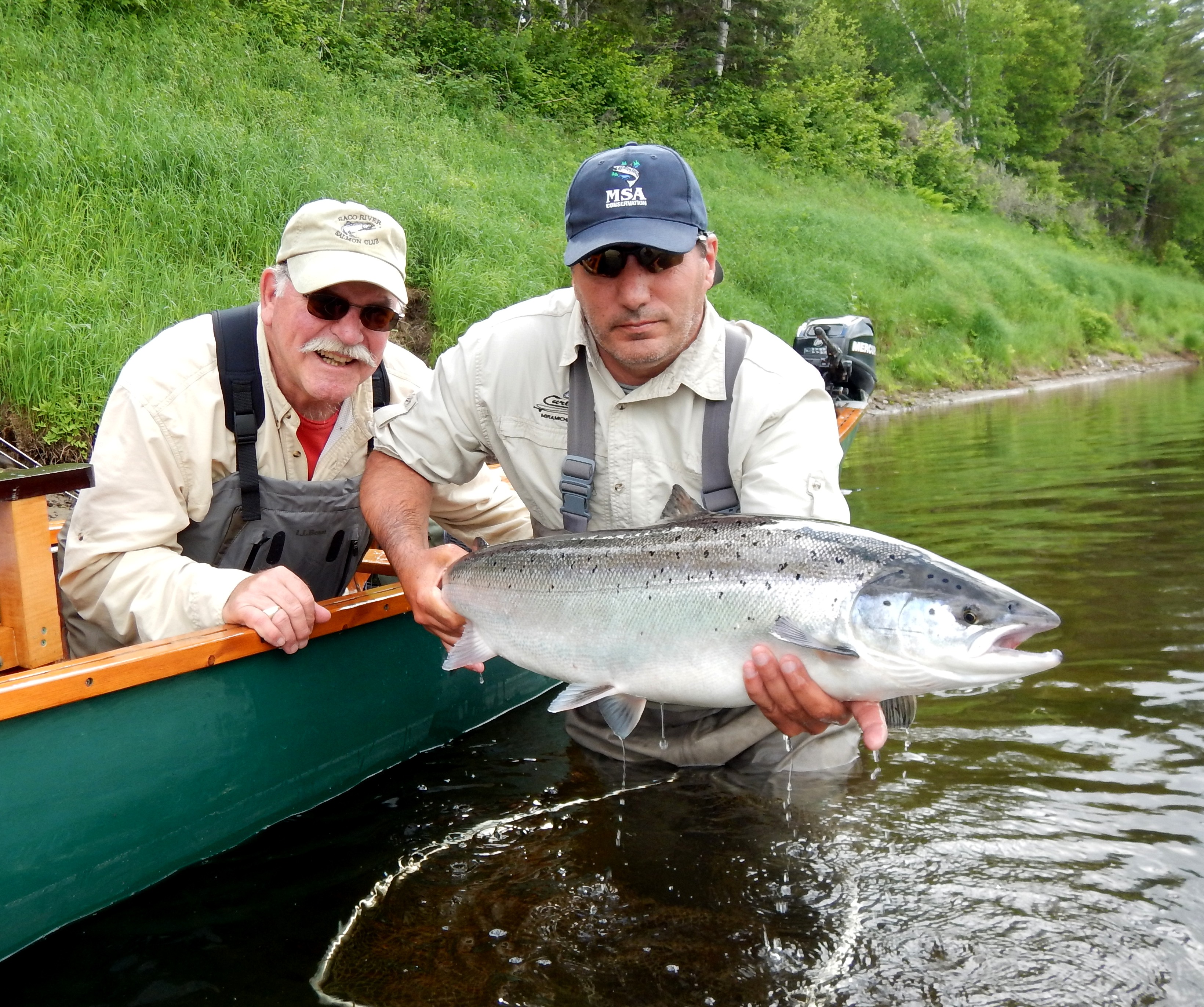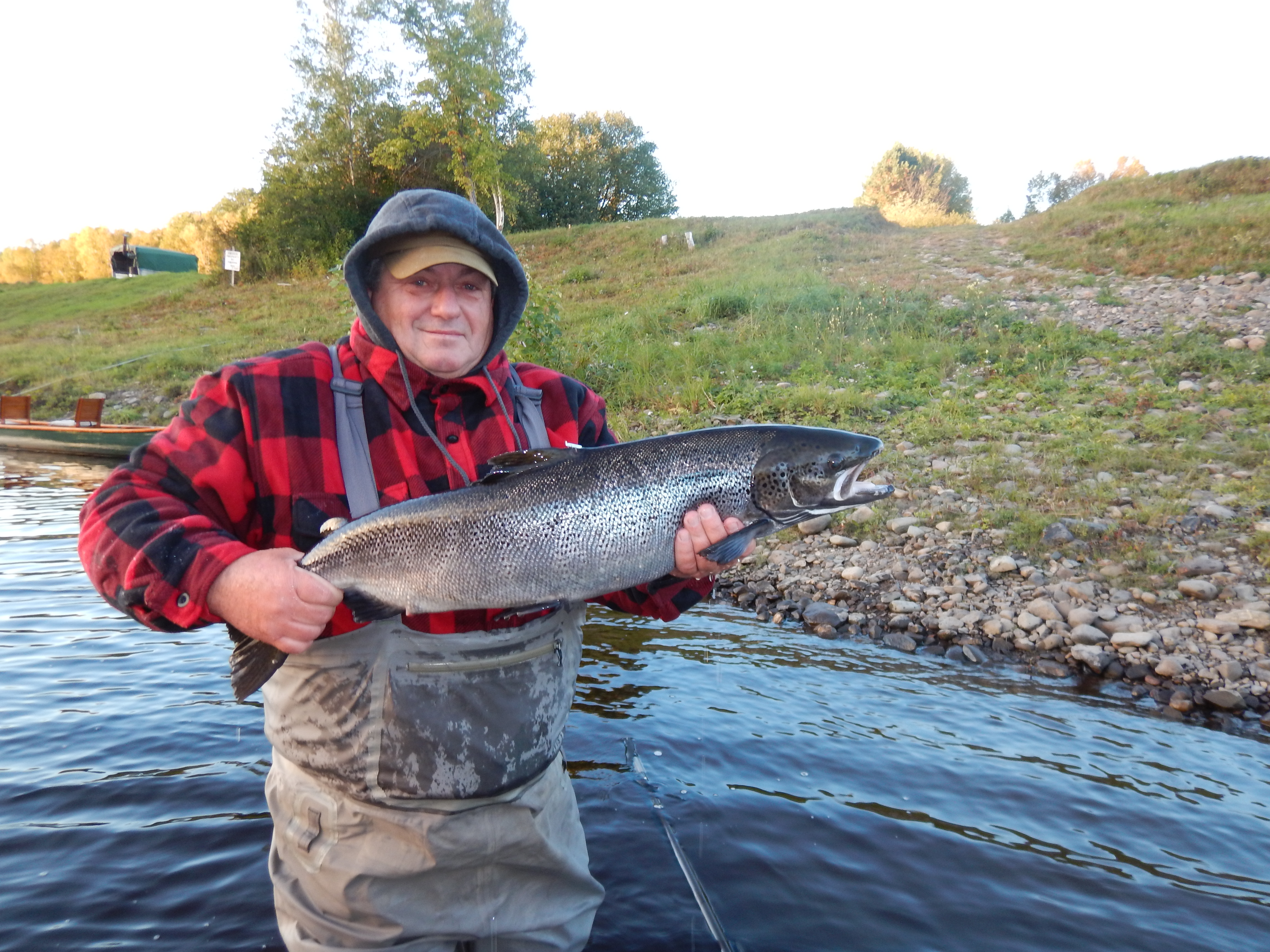
July 15 Atlantic Salmon Trap Counts
Fishing Friends –

Fish trap where salmon are captured, tagged, and released. The number of tagged Atlantic Salmon later recovered are extrapolated into an estimate of the salmon run for the year.
Recently the New Brunswick Department of Fisheries and Oceans published the July 15th fish trap numbers for the Millerton trap on the Southwest Miramichi, as well as the counts for a number of other locations in the Province. As a general statement the numbers were quite positive. The Northwest Miramichi was the only notable exception to trend. Larger salmon – as opposed to grilse – numbers were up marginally on the Southwest Miramichi at Millerton from 71 in 2018 to 74 for 2019. At Mactaquac on the Saint John they were up from 50 to 164, and on the Nashwaak they jumped from 7 to 21. At Cassilis on the NW Miramichi, though, they were down from 32 to 26 which is essentially a record low.
The grilse numbers, though, were much more impressive. The grilse have to spend only one year at sea, so they may more accurately reflect the past winter’s sea survival conditions. Sea survival is considered to be the main issue with declining salmon returns since the percentage of smolts that go to sea and manage to live to return for spawning has dropped from something like 10% back in the 1970s to not much over 1% in some recent years.
Grilse on the SWM were up from 128 to 273. While that is still far below the 500 or so averaged 20 years ago, it is a substantial increase over 2018’s 128 and 2017’s 193. Things are definitely headed in the right direction there. They were also up substantially from 211 to 378 on the Saint John, and 21 to 64 on the Nashwaak. The NWM saw a grilse increase from 107 to 139. One must always remember with these numbers that the Miramichi counts – unlike the Saint John and Nashwaak where every fish is counted – reflect only a sampling of the fish that enter the river. Historically the Millerton net catches only 5% of the salmon and 9% of the grilse, though it varies considerably from year to year depending on various factors including water height and temperature.
Another indication is the Dungarvon Barrier count done by the Department of Natural Resources. The Dungarvon is a tributary of the Renous that meets the Southwest Miramichi at Quarryville. Its watershed lies essentially between those of the Southwest and Northwest Miramichi. The timing of the Dungarvon Barrier counts is different than the others, but here they are through July 14: Grilse were up over 2018’s 26 to 45 this year, small salmon between 64 and 85 cm were up from 12 to 18, and salmon over 85 cm from 26 to 28 this year. In total all Atlantic salmon counted in the trap were up from 64 to 91 – a solid 42% increase.
Also counted at Dungarvon are sea run brook trout, and that number was up from 6 in 2018 to an amazing 95 this year! I checked with Miramichi Salmon Association President Mark Hambrook and he had no explanation for big brook trout count, but was very pleased to see the improved returns of both Atlantic salmon and brookies.
Every year is different, and the trend in recent years has been back towards a very heavy emphasis on “late running fish” that appear in late September and October to make up the majority of the run. In 2018 Millerton’s July 15 count was down from 92 in 2017 to 71, but when the season was over 2018 surpassed 2017 by 670 to 584. That means there is plenty of time for the final 2019 outcome to be much different than we currently see it. Those early silver fish, though, are the finest of the year, and it is great to see an uptick in the numbers.




Encouraging numbers with the exception of the NW.
Runs of fall-spawning species are getting later elsewhere, too. Possible effect of climate change, warmer water, and later cooling.
One of the questions I’ve asked is when do we think fall run rivers like the Northumberland shore rivers of Nova Scotia evolved in that fashion? Were they fall run rivers in the 1700s? No one seems to know the answer to that, though I imagine some historical digging could turn it up. To a large degree the Cains is now a fall run river, and has been considered that as far back as any reading that I have done. Emery Brophy tells me, though, that fishing with his father John who had been on the river with Harry Allen since the early 1900s, that they used to “sail” the river in July, and routinely had a shore lunch of grilse that they caught much further up the river then we now regularly find grilse in mid summer. Perhaps we will find that the Miramichi is headed the way of the Cains in that regard. I’m not at all convinced of that, though, because the headwaters of the Miramichi are really up in highlands that reminds one more of the Restigouche than the Cains.
Brad, Thanks for your accurate updates from the trap nets. Am happy that they are encouraging. Jack
Brad, do you have any news about stripers in the Miramichi ?? — whether their numbers have increased or decreased, and whether anything is being done by DFO to protect salmon in the river rather than stripers.
Ben – there is a general feeling that the striper population has declined somewhat, though clearly there are still loads of them. I understand that they use a mark and recapture program with the gaspereaux netting stations to estimate the actual size of the population, and that it is a pretty rough estimate at best. I have not heard any recent estimates. There was some minor liberalization of striped bass catch restrictions this spring, and the First Nations are now allowed a small commercial catch of striped bass.
One of the factors which may be helping the count for the summer run might be the lifting of the Greenland nets. This is the first full cycle year where that might contribute to the up tick. We will know more if the grille uptick is sustained over multiple years. There still appears to be a smooth survival issue for Miramichi Salmon and no definitive answers just a whole lot of conjecture.
Thanks for your comment John. Whatever has caused the grilse turn around, it is most welcome. Let us hope the second half of the season is even better.
Good news. Hope there will be no restrictions on fishing this year even though it is warm down here in MA. Just back from the St. Jean in Gaspe. Water was a bit low even with the large amt. of snow and a cool spring, but there were lots of salmon in the river and many big ones ( none of the big ones dared to attack my fly, although I did land a 15 lb. one on my 1 oz. for a 2 weight line Orvis using a green machine size 10 hook !!!!) compared to the last few years. Looking forward to my visit in Sept. and hope there is cooler weather than last year but the friendship makes up for slow fishing. Will be bringing lasagna, bacon, wine, farm fresh eggs, great bread and your favorite friend the Grouse. Let me know if you want anything else?? Can’t wait and tight lines, Rick.